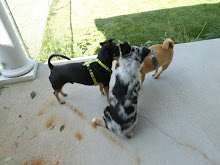I made this one for my sister-in-law after she said that her favorite colors are orange and yellow.
I was short on orange and yellow fabrics. I wanted to keep the print images small, so I picked this darker fabric with little specs on it for the pocket, but it kind of eclipsed the tote, so I added the stripes to match the straps. It makes the tote look a bit sporty, which wasn't my intention, but does brighten up the front. A while back my husband offered to get me an embroidery machine, and I thanked him, but said no because I didn't have the room for one. This is a case where putting embroidery on the front pocket would have looked nice. Oh well.
This is the first time I did not follow the directions on how to position the magnetic snap tabs. The instructions have you set it up so that the tabs hang down while connected. I wanted to see how it would work out if I overlapped them. Turns out it worked out just fine.
I love this fabric. I can't believe I had it just sitting around in my stash all these years.
Tuesday, May 26, 2020
Wednesday, May 6, 2020
Summer Tote
My daughter picked out the colors of yellow and blue for her tote. I laid out groups of fabric and texted pictures of them to her from my mobile phone. I gave her a choice of two pockets or four. She chose four, and then I gave her the choice of having all four pockets on the front or around the bottom half of the tote. This is the final product...
I've been working from my old stash of fabric, so I find it amazing that the blues and yellows of all three fabrics matched perfectly in tone and style. My daughter has an artistic eye.
Lessons learned from this project:
1. Stop back-stitching when the instructions tell me to baste. Baste means that I'm going to need to rip out the stitches in the future. I managed to tack the tops of each pocket pleat closed. If I chose to rip out the stitches, I would have destroyed the fabric, because I actually triple stitched those areas. I decided to leave the pockets as is since items will be less likely to fall out with the top of the pockets being tighter than the middles. In the future I will have to highlight the word "baste" throughout the instructions and perhaps hand baste instead of using the machine on its longest setting.
2. The sky fabric was more like a dyed sheet fabric than quilting cotton, so it was quite fragile to work with. No matter how much ironing I did, it just kept wrinkling as soon as I touched it. Also, the edges lost a lot of real estate as it shed threads along the way. I probably should have serged all the edges before sewing. For any bag I plan to sell, I'll have to check the quality of the cotton.
3. I keep forgetting the proper iron settings for each layer. The fabric can handle the cotton setting, while the interfacing and fleece cannot. I'm not supposed to touch the iron directly to the fleece or it will shrink and burn. Every time that I have to iron a piece of fabric that already has some fleece attached, the fleece falls off and I have to sew it on. So, in the future I'm going to need an iron settings cheat sheet to save me the time lost when having to correct damage caused by hasty ironing.
Now, onto the next project...
I've been working from my old stash of fabric, so I find it amazing that the blues and yellows of all three fabrics matched perfectly in tone and style. My daughter has an artistic eye.
Lessons learned from this project:
1. Stop back-stitching when the instructions tell me to baste. Baste means that I'm going to need to rip out the stitches in the future. I managed to tack the tops of each pocket pleat closed. If I chose to rip out the stitches, I would have destroyed the fabric, because I actually triple stitched those areas. I decided to leave the pockets as is since items will be less likely to fall out with the top of the pockets being tighter than the middles. In the future I will have to highlight the word "baste" throughout the instructions and perhaps hand baste instead of using the machine on its longest setting.
2. The sky fabric was more like a dyed sheet fabric than quilting cotton, so it was quite fragile to work with. No matter how much ironing I did, it just kept wrinkling as soon as I touched it. Also, the edges lost a lot of real estate as it shed threads along the way. I probably should have serged all the edges before sewing. For any bag I plan to sell, I'll have to check the quality of the cotton.
3. I keep forgetting the proper iron settings for each layer. The fabric can handle the cotton setting, while the interfacing and fleece cannot. I'm not supposed to touch the iron directly to the fleece or it will shrink and burn. Every time that I have to iron a piece of fabric that already has some fleece attached, the fleece falls off and I have to sew it on. So, in the future I'm going to need an iron settings cheat sheet to save me the time lost when having to correct damage caused by hasty ironing.
Now, onto the next project...
Subscribe to:
Comments (Atom)











